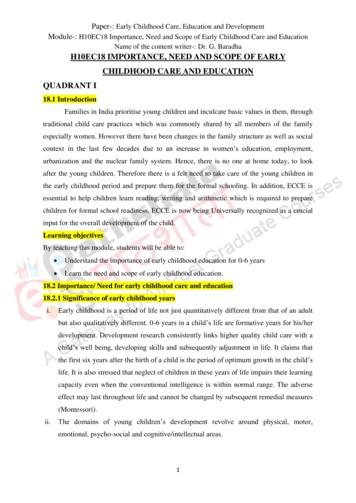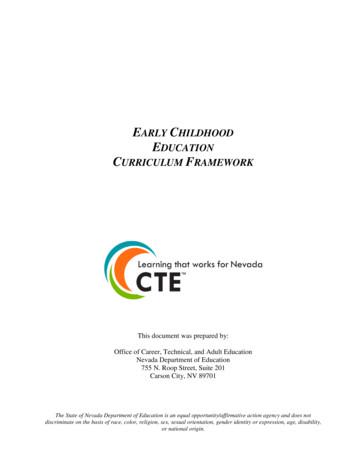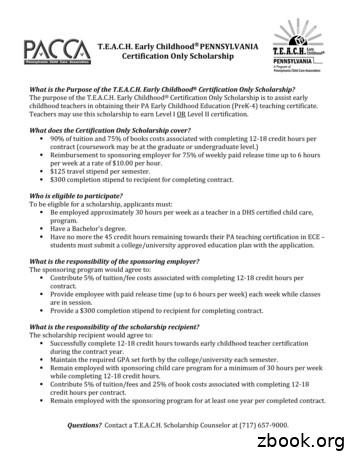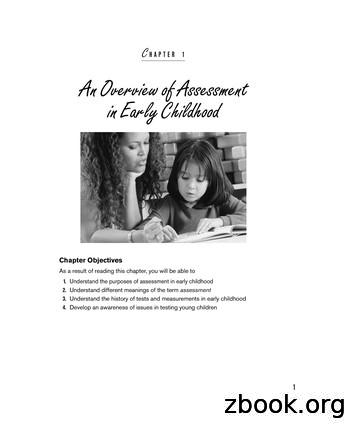Peace Education In Early Childhood Education
Volume 8 Number 2 (2014): 167-188http://www.infactispax.org/journalPeace Education in Early Childhood EducationStacey M. AlfonsoUniversity of ToledoIntroductionEarly childhood education in the United States focuses on educating the youngest of ourcitizens. Although the age range of what is considered “early childhood” for teacher certificationpurposes may slightly differ from state to state, it is generally understood that early childhood isbirth through age eight. In practice, early childhood education tends to specifically focus onthose children younger than primary school grades. Ideas of early childhood have evolved,shifted and transformed over time. The ideas of many theorist, philosophers and educators fromPlato, Rousseau and Pestalozzi to Piaget, Vygotsky and Dewey have been addressed, debatedand applied to a variety of issues in early childhood.1Approaches to early childhood education may vary in the United States but there tends tobe an universal emphasis on educating the “whole child” which encompasses understanding theimportance of supporting a child in all developmental domains including cognitive, physical,language, social and emotional.2 The general holistic approach to early childhood educationseems to create an open door to the integration of peace education within the early years ofchildhood. This is supported by Betty Reardon's recognition that the “holism of early educationsets learning in a context of the linkages and interrelationships between cognition and affect andamong subjects of study that more closely approximates the natural learning of lived1Weber, E. Ideas Influencing Early Childhood Education: A Theoretical Analysis. New York, NY: TeachersCollege Press, 1984.2Roopnarine, J. L., & Johnson, J. E. Approaches to Early Childhood Education. Upper Saddle River, N.J:Merrill/Pearson, 2009.In Factis PaxVolume 8 Number 2 (2014): 167-188http://www.infactispax.org/journal167
experience.”3 It is within this environment of interrelationships and a more natural learningprocess that peace education can be most fully realized.This paper is meant as an introduction to the idea of peace education in early childhoodand will focus on the broad possibilities of creating a pedagogical framework for early childhoodfounded on peace education. Throughout this paper I will discuss early childhood educationwithin a framework of peace education, using the human rights and peace education approach asthe main directive with elements of other approaches to peace education integrated. Specialattention will be given to the advantages of including a component of education in an outdoornatural setting.Before discussing the importance of nature in peace education or early childhoodeducation in general, a very brief background and introduction to peace education will be givento provide a basic understanding of this broad and growing field. This will be followed by adiscussion of the importance of peace education in an early childhood setting, including theimportance of nature and outdoors in the curriculum. After laying that structure, I will propose acurricular framework for early childhood based on the values of peace education that will rest onfour pillars; value and respect for self, appreciation of diversity, sense of fairness and justice, andawareness of interconnectedness.Overview of Peace EducationIn order to set the stage for the proposal of an early childhood peace curriculum, anoverview of the peace education field will be presented. To begin, Betty Reardon breaks downpeace education to education for peace, education about peace and peace knowledge.4 Educationfor peace is concerned with creating preconditions necessary for peace, helping to build the skillsand knowledge necessary for peaceful interactions and endeavors. Education about peaceteaches about what peaceful conditions are and what the essence of peace is. Peace knowledgeincludes such things as peace research, peace studies and peace education.While keeping in mind Betty Reardon’s foundation for peace education, it is alsoimportant to note that various forms to peace education exist, all are currently being developed,maintained and investigated. Since each of these forms takes a slightly different point of viewand emphasis, they will be briefly examined separately.Comprehensive peace education takes a wide-lens view of the subject, integratingnegative peace and positive peace; negative peace as the absence of direct violence and positivepeace as the existence of a socially just society. 5 Both pieces play an integral part of3Reardon, Betty A. Human Rights Learning: Pedagogies and Politics of Peace. UNESCO Chair for PeaceEducation Master Conference: University of Puerto Rico, 2009, 5.4Reardon, Betty A. (1999). "Peace Education: A Review and Projection." Sweden: School of Education, MalmoUniversity.5Galtung, Johan. Violence, Peace, and Peace Research. Journal of Peace Research, 27 (1969): 291-305.In Factis PaxVolume 8 Number 2 (2014): 167-188http://www.infactispax.org/journal168
comprehensive peace education and challenge educators to consider both these elements whilereflecting on all aspects of peace from a personal to a global perspective.6Danesh in his integrative peace education approach, argues that “peace in its essence is aspiritual state with political social and ethical expressions” and that “peace must first take placein the human consciousness.”7 His focus was on creating a world-view based on unity which hebelieved is determined by human cognitive and emotive capacities.Critical peace education grew from Paulo Freire’s Pedagogy of the Oppressed intended toreflect on oppression and action upon which to take in order to transform the world. Criticalpeace education is meant to be problem-posing, dialogical and analytical in nature leading to acritical consciousness for transformative action.8Gender perspective and human rights peace education challenge the brute forceful viewsand values of people in power, specifically those of a patriarchal society. Through this view,human rights (including gender rights) can be seen as a counter to violence and a way to achieveequality, justice and peace. It is built on the “fundamental belief in moral equality, a belief thatall human beings possess an equal inherent dignity or worth."9While discussing gender perspective in peace education, Betty Readon would refer to“humane persons” as those peace makers who are gender sensitive. I would elaborate on theidea of humane persons as those who believe in a moral equality for all, which includesdifferences in gender but also differences and variations found among human diversity at large.10Ethical approaches to peace education explore the ethical, spiritual and philosophicaldimensions of peace education. Within this exploration, care theory (concerned with creatingtwo-way caring relationships) and the need for public reason and deliberation are includedwithin a cosmopolitan perspective which transcends societal boundaries.11Eco-peace, a more recently developed branch of peace education, calls for the need toconsider creating peace with the world as a whole, including all living things and our natural6Reardon, Betty A. Comprehensive peace education : Educating for global responsibility. New York: TeachersCollege Press, 1988.7Danesh, H. B. Education for Peace Reader. Victoria, Canada: EFP Press, 2011, 23.8Freire, Paulo. Pedagogy of the Oppressed. New York: Continuum, 1970; Bartlett, Lesley. "Paulo Freire and PeaceEducation." In Encyclopedia of Peace Education, edited by Monisha Bafa. Charlotte, NC: Information AgePublishing, Inc., 2008; Baja, Monisha. "'Critical' Peace Education." In Encyclopedia of Peace Education, edited byMonisha Baja, 135-146. Charlotte, NC: Information Age Publishing, 2008.9Snauwaert, Dale T. "Human rights and cosmopolitan democratic education." Philosophical Studies in Education,40 (2009): 94.10Reardon, Betty A. Education for a Culture of Peace in a Gender Perspective. Paris: UNESCO, 2001.11Noddings, Nel. "Caring and Peace Education." In Encyclopedia of Peace Education, edited by Monisha Baja.Charlotte, NC: Information Age Publishing, Inc., 2008; Snauwaert, "Human Rights and Cosmopolitan DemocraticEducation;" Snauwaert, Dale T. "Democracy, Public Reason, and Peace Education." Global Campaign for PeaceEducation Newsletter, 88 (2011): 1-5.In Factis PaxVolume 8 Number 2 (2014): 167-188http://www.infactispax.org/journal169
systems, creating an education for sustainability as an element of peace education.12 A goal ofsuch an approach would be “‘to have humans live in peace with nature, appreciating that theirown survival and health depends upon the health of water, air, plants and animals."13Approaches to peace education vary widely but all hold similar characteristics and goals.All forms of peace education are concerned with cultivating citizens of a cosmopolitanperspective who are capable of working towards a humane and just society. I think BettyReardon most clearly and succinctly lays forth the purpose of peace education as promoting “thedevelopment of an authentic planetary consciousness that will enable us to function as globalcitizens and to transform the present human condition by changing the social structures and thepatterns of thought that have created it.” 14 If peace education is on the forefront of earlychildhood, it becomes feasible that there will be less need for change in the patterns of thoughtand world views and more emphasis on the establishment of world views for peace.Early Childhood as a Foundation of PeaceEarly childhood is a time when a child is laying the foundation for future developmentcapabilities across all domains. The interplay of language, cognition, social-emotional capacitiesand physical abilities come into use more frequently and purposefully. As children developlanguage, they use it to convey their needs and wants, express their emotions, and verbally solveconflict. As children’s cognitive ability allows them to see a distinction between themselves andothers, they use their new social skills to test out friendship-making capabilities. Because ofthese great steps in development, early childhood becomes a crucial time for developing theskills and capacities necessary for peace making, peace keeping, and peace building. Earlychildhood educators can be instrumental in building those capacities in what Betty Reardonmight refer to as teaching for peace, which as mentioned earlier is concerned with creatingpreconditions necessary for peace.Supporting the importance of including a peace curriculum in early childhood is researchwhich has helped uncover optimal developmental periods of the brain. It is the early years of lifethat are considered “prime time” for brain development which can affect a child’s socialcapacities, critical to preconditions necessary for peace. It was found that “both quality of careand security of attachment affect children’s later capacity for empathy, emotional regulation, andbehavioral control."15 This suggests that if peace education is included in early childhoodexperiences it can be extremely influential in building a child’s later capacities for peace such asempathy, emotional regulation and behavioral control which will prove to be important pieces.Betty Reardon describes human rights as the “ethical core” of peace education.16 When better to12Brenes, Abelardo. "Education for Sustainable Development Based on the Earth Charter." In Factis Pax 2, no. 1(2008): 1-29; Mische, Patriacia & Harris, Ian. "Environmental Peacemaking, Peacekeeping, and Peacebuilding." InThe Encyclopedia of Peace Education, edited by Monisha Baja. Charlotte, NC: Information Age Publishing, 2008.13Mische & Harris, "Environmental Peacemaking, Peacekeeping, and Peacebuilding," 3.14Reardon, Comprehensive Peace Education, x.15Shore, R. "‘What have we learned?’ in ‘Rethinking the brain'." New York: Families and Work Institute, 1991, 41.16Reardon, Betty A. Human Rights Learning: Pedagogies and Politics of Peace. UNESCO Chair for PeaceEducation Master Conference: University of Puerto Rico, 2009, 2.In Factis Pax170Volume 8 Number 2 (2014): 167-188http://www.infactispax.org/journal
build this core of human rights understanding (along with other capacities for peace) than duringthe early childhood years when the core of the person themselves is being built? Early childhoodshould be used as a place to lay down the building blocks for our future peace leaders.Including Nature and Outdoor Experiences in the Early Childhood CurriculumNature provides an abundance of rich experiences for children in which these buildingblocks can be formed. These experiences have the potential to provide strong learning anddevelopmental opportunities for all children as well as play a key role in developing a peacecurriculum for early childhood. Providing time in nature will allow children at an earlychildhood level to have unique opportunities for growth in all domains of development; social,emotional, cognitive, language, and physical. For young children, outdoor time in nature willprovide the setting for more active physical endeavors while enhancing motor fitness, balance,agility, body awareness, motor planning, and coordination. In addition, this time has greatpotential to allow for children to partake in more active communication, social-emotional skillsand cognitive endeavors as well. Outdoors in nature children will be constantly challenged touse problem solving and decision making skills in an ever changing and sometimesunpredictable environment. The freedom and open-endedness of the natural environment allowsthem to develop play and communication skills crucial to language, social, and emotionaldevelopment. Being in nature will also enhance opportunities for children to find patterns,similarities and differences using critical thinking and creative skills while developing a bondwith nature and being exposed to a bigger more interconnected pictures of the world in whichthey live. Including this component of exposure to nature and natural experiences providesopportunities for healthy developmental growth and as this paper will highlight, opportunities forthe integration of peace education and building the child's capacities for an understanding ofpeace.Pedagogy of Peace in Early Childhood: Standing on Four Pillars of PeaceIt is through the establishment of four pillars of peace that I propose an early childhoodpeace education curriculum: self-value and self respect, appreciation of diversity, sense offairness and justice, and the awareness of interconnectedness. These four elements will be usedto create a curricular framework for early childhood educators who wish to embrace peaceeducation and create a classroom culture based on peace.Self-Value and Self-RespectIn order to help children develop the skills to build and maintain peaceful relationshipsand endeavors, early childhood educators must recognize the importance of creating a positiveself image built on love and respect for oneself. In learning to love and value oneself, self-worthcan be recognized. In understanding one’s self-worth, one can believe they deserve a just andpeaceful society therefore becoming capable of striving for it. If we are not to value and respectourselves, than how can we envision the most just situation for ourselves and others? BettyReardon acknowledges that learners of all ages must examine and challenge the current practicesIn Factis PaxVolume 8 Number 2 (2014): 167-188http://www.infactispax.org/journal171
and situations, including affairs of person justice.17 With a strong sense of self worth and apositive identity, one can stand up for oneself and the injustices which they experience. Theearly childhood years are most important in developing this value of self because this is a timewhen the sense of self is taking major steps in development.In reference to sense of self development, work by developmental psychologist, ErikErickson established that a sense of trust was the first and most basic stage as babies and veryyoung children form a relationship with themselves and their social world. In the following earlychildhood years, he proposed that autonomy and initiative were essential as children develophealthy self and social relationship. 18 Through interactions with peers, adults and theenvironment, children get to know themselves; their abilities, their preferences and theirfeelings.19 When children enter an early childhood school environment, the possibility to interactwith peers, adults and multiple environments is dramatically increased, therefore creating greatopportunity to enhance trust, autonomy and initiative.Education and the learning process itself becomes a natural setting in which theseelements and other sense-of-self growth can take place. According to Reardon “true learning [is]an organic, vibrant process through which we develop our human identities and socialcapacities.”20 In a sense this conceptualization of learning is meant for all educators who striveto espouse peace education but early childhood educators should pay particular attention to thisnotion. They must promote this “true learning” as a way to develop their young students’ identityand social capacities and in doing so enable children with the potential to help build a peacefulsociety. Contributing to the idea of social capacities, Dale Snauwaert makes a clear connectionbetween peace education and the facilitation of public reason and deliberation.21 If children areto one day become citizens involved in public reason and deliberation in order to further peacefulefforts, a strong understanding and respect for self will play a major role in successfully doingso. One must know one's self, their capacities and understand their thoughts if they are tocontribute to such reason and deliberation towards a movement of peace.It is also through love and respect of oneself that love and respect for others can begrown. We must first love and understand ourselves as people in order to love and respect othersas people. This self awareness and self respect will help a child understand the respect anddignity that should be applied towards others because, as Dale Snauwaert writes “a sense ofjustice, grounded in a proper sense of self-respect, is a capacity and higher-order regulativedesire to affirm and act from a recognition of moral reciprocity, to offer to others terms of socialcooperation that they would agree to under conditions of equality and fairness.”22 These terms of17Ibid.Crain, W. C. Theories of Development: Concepts and Applications. Upper Saddle River, N.J: Pearson/PrenticeHall, 2005.19Ormrod, J.E. Educational Psychology: Developing Learners, 7th edition. Boston, MA: Pearson Education Inc.,Allyn & Bacon, 2001.20Reardon, Human Rights Learning, 2321Snauwaert, "Democracy, Public Reason, and Peace Education."22Snauwaert, Dale T. "Upholding a Human Right to Peace." Global Campaign for Peace Education Newsletter, no.105 (2013): 5.18In Factis PaxVolume 8 Number 2 (2014): 167-188http://www.infactispax.org/journal172
social cooperation can begin to be tested and strengthened as children gain a sense of themselvesand others while early childhood educators guide children towards an understanding of moralreciprocity.First classroom experiences are also a time in which children learn their value within aclassroom or community and begin to gain a sense that they are an accepted, appreciated memberof a group. Early childhood educators should be supportive in the development of a child’sappreciation and respect for self through helping each child become a vital member of theclassroom community. Through a caring, thoughtfully planned environment, teachers of youngchildren can help establish the sense of self worth and self respect.It is through getting to know oneself and her/his value and acceptance in a community,that children can become aware of their place in the
education in general, a very brief background and introduction to peace education will be given to provide a basic understanding of this broad and growing field. This will be followed by a discussion of the importance of peace education in an early childhood setting, including
Understand the importance of early childhood education for 0-6 years Learn the need and scope of early childhood education. 18.2 Importance/ Need for early childhood care and education 18.2.1 Significance of early childhood years i. Early childhood is a period of life not just quantitatively different from that of an adult
Early Childhood Education I L1 Early Childhood Education II L2 Early Childhood Education III L3C Early Childhood Education Advanced Studies AS The core course sequencing with the complementary courses provided in the following table serves as a guide to schools for their programs of study.
ECE 240 - Administration of Early Childhood Care and Education Programs (3) ECE 241 - Administration: Human Relations for Early Childhood Education (3) Colorado Mesa University B.A. Early Childhood Education - Early Childhood Special Education Advisor: Vail Shoultz-McCole vshoultz@coloradomesa.edu 970-255-2674
Early Childhood Care, Development and Education (ECCDE) is a term that is used interchangeably worldwide but refers to the same concept of early childhood education and cognitive development. The World Bank for instance refers to it as Early Childhood Care and Education, whereas UNESCO refers to it as Early Childhood Development Care.
T.E.A.C.H. Early Childhoodâ PENNSYLVANIA Certification Only Scholarship What is the Purpose of the T.E.A.C.H. Early Childhood Certification Only Scholarship? The purpose of the T.E.A.C.H. Early Childhood Certification Only Scholarship is to assist early childhood teachers in obtaining their PA Early Childhood Education (PreK-4) teaching certificate.
Center-Based and Family Child Care Early Childhood Education Reviewer The Early Childhood Education (ECE) Reviewer must meet one of the following sets of education and experience options: Education and Experience Option I 1. B.A., B.S., or advanced degree in early childhood education/child development or home
surrendered. The peace that is Christ’s peace is bequeathed to such a person. Jesus said it. “Let not your heart be troubled My peace I give unto you.” What peace? My peace, Jesus says; that peace which rules in heaven because Jesus is the everlasting Father, the Prince of Peace, and the Holy Spirit is too. We are to
CHAPTER 1 An Overview of Assessment in Early Childhood Understanding Assessment in Infancy and Early Childhood Not too long ago, resources on early childhood assessment were limited to occa-sional articles in journals, chapters in textbooks on teaching in early childhood pro-grams, and a few small textbooks that were used as secondary texts in .























